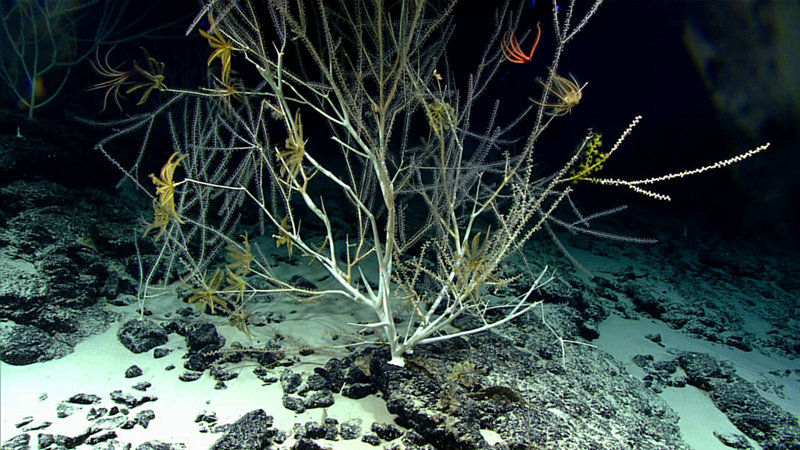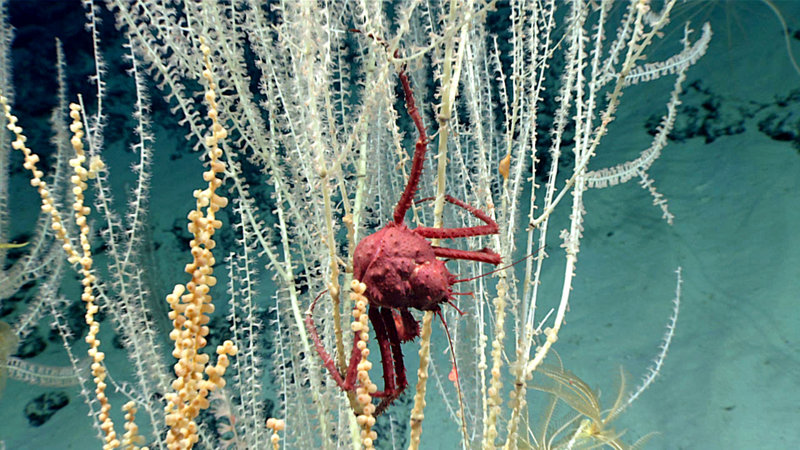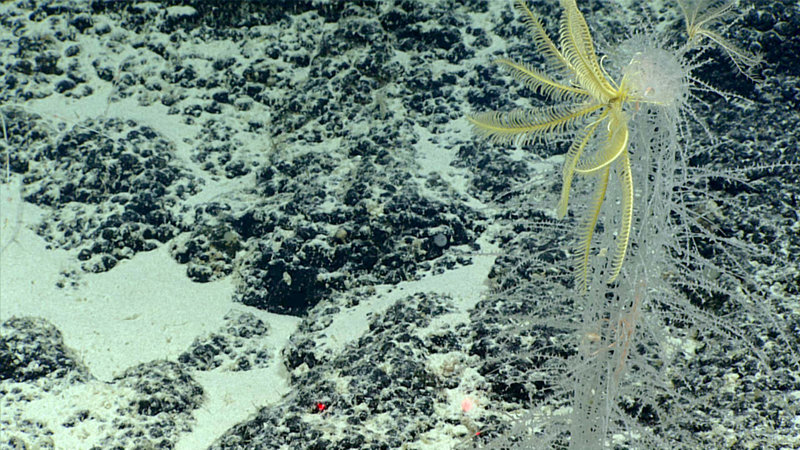
By Malcolm Clark, National Institute of Water and Atmospheric Research, New Zealand
May 4, 2017

Large bamboo corals (subfamily Keratoisidinae), with feather stars and brittle stars attached to their branches, were very common throughout Dive 03 at "Te Kawhiti a Maui Potiki." Image courtesy of the NOAA Office of Ocean Exploration and Research, Mountains in the Deep: Exploring the Central Pacific Basin. Download larger version (jpg, 1.6 MB).
Kia orana!
Biodiversity in the deep waters around the Cook Islands is poorly known. Much of our existing information comes from a voyage of the German research vessel Sonne in 2007, which used a combination of dredges, grabs, corers, and some photographic transects to explore offshore areas of the Manihiki Plateau. The general findings of that survey were that benthic fauna were not particularly diverse and not abundant. The term “impoverished” was used. This was attributed to the region being one of low surface productivity. As many deep-sea animals, like sponges and corals, are filter-feeders (sieving the passing water for food), they rely upon dead plankton and particles sinking from the surface waters. Therefore, low productivity areas sometimes provide little food to the deep.

A close-up view of a bamboo coral, with a small king crab (genus Paralomis) hanging on. Image courtesy of the NOAA Office of Ocean Exploration and Research, Mountains in the Deep: Exploring the Central Pacific Basin. Download larger version (jpg, 1.5 MB).
During the Mountains in the Deep expedition, NOAA Ship Okeanos Explorer planned to move from American Samoa to Honolulu, Hawaii, which gave New Zealand and Cook Island scientists the opportunity to recommend mapping and remotely operated vehicle targets to improve our knowledge of both the geological evolution of the area and the biodiversity associated with plateau, seamount, and abyssal plain/ridge habitats. Although not in American waters, the objectives of this work linked well with the regional goals of the Campaign to Address the Pacific monument Science, Technology, and Ocean NEeds (CAPSTONE).
Two successful dives during the current Mountains in the Deep expedition, on April 30 and May 2, revealed new insights into life in the deep. The dives occurred in the High Seas, just north of the Cook Islands region. One was on part of the northern extension of the Manihiki Plateau and the second was on a deep ridge to the east.
The first site, dubbed "Te Tukunga o Fakahotu," was at depths of 2,500 meters (8,200 feet) coming up a ridge on the plateau to about 2,100 meters (6,890 feet). The seafloor was predominantly ferromanganese crust, with a variety of benthic fauna (black corals and octocorals, sponges, feather stars, and sea stars), but these were scattered and not abundant.
After the April 30 dive, the next dive, on a deep ridge dubbed "Te Kawhiti a Maui Potiki," was startling in the abundance of corals. The transect started at just over 2,200 meters (7,220 feet) depth, and came up the side of the ridge to summit at 2,100 meters (6,890 feet). From the start of the dive, we encountered large bamboo corals. Initially, there were just a few corals, but then quickly we came across high densities ("forests") where corals were packed onto most exposed rock surfaces. Their branches were host to numerous feather stars and brittle stars. The type of coral couldn't be confirmed from photos, beyond being in the family Keratoisidae, so a sample was collected. The corals were sometimes over three meters (10 feet) in height and were very brittle. They continued to dominate the slope as we got shallower until the end of the dive – we were treated to almost five hours of very cool imagery!
Another highlight from the May 2 dive was a potential new species of glass sponge, resembling a transparent hairy vase. This was confirmed to be in the genus Walteria, and although believed to occur off Hawaii and New Zealand, it has not yet been described or named. A specimen of the sponge was collected, which will be important for helping to describe the sponge in scientific literature.

The sponge (Walteria sp.) with a feather star attached. Image courtesy of the NOAA Office of Ocean Exploration and Research, Mountains in the Deep: Exploring the Central Pacific Basin. Download larger version (jpg, 1.8 MB).
These two dives enabled the shipboard team and shore-based scientists to record a wide range of benthic fauna and to confirm that certain species can be abundant in some localities. We don't know why the bamboo corals were almost absent at the first site, yet so abundant at the second, but these data contribute to a jigsaw puzzle that will help us compare where species occur and the environmental conditions (topography, current flow, temperature, depth, etc.) at those localities. This helps us to understand the distribution of species in the general region, as well as large-scale biogeographic patterns of benthic communities extending down to New Zealand.
These data are also an important contribution to knowing what might occur in the deep sea closer to the Cook Islands, where a large marine park ("Marae Moana") is in the final stages of being legislated by the Cook Islands government. This in turn can help the development of environmentally sustainable management of human activities in the area.
The Cook Island and New Zealand scientists and managers involved in the planning and operation of the dives are very appreciative of the opportunity afforded by NOAA and the NOAA Ship Okeanos Explorer team.
Meitaki.